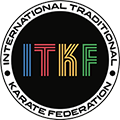 |
Register and protected by WIPO |
Objectives and Values
"In traditional karate victory is not an ultimate aim. Tradition karate is an art of self-defence which uses only and in the most efficient way human body. It employs mainly blocking, blowing, punching and kicking techniques?"
The purpose of Traditional Karate is to develop well-balanced mind and body, through training in fighting techniques. Traditional Karate also shares the ultimate aim with Budo, which is to cultivate great human character of a higher class that prevents any violent attack before an actual fight occurs.
Budo originates in the practice of physical fighting; however, it has a significant effect on the spiritual and physical development of a human since Budo philosophy and ethics are absolute requirements for the study of techniques and improvement of skills. Elements such as manners and etiquette were not adapted from outside elements nor are they independent from the physical training, but existed within the system since the origin of Budo and were integrated to the technical improvement:
-
Seriousness
- Budo training must be done in a serious manner, because its techniques are derived from severe life-or-death situations, where one must win the fight in order to survive. This is why Budo practitioners are required to have a serious mind set. Only in such a condition can one possibly achieve extreme levels of mind and body far beyond ordinary levels. This is apparent in competitions. For example, a Kumite (sparring) match is carried out in Ippon-shobu (one perfect “finishing blow” determines the winner) format. Because only one definitive technique can conclude a match, competitors are driven to learn the importance of serious attitude.
-
Humility
- To achieve a higher level, Budo requires a practitioner to keep a humble mind and behavior. This allows one to always learn something from anyone. Once one thinks that he or she is better than others, the possibility of improvement ceases. This is the basis of the high importance of respecting instructors as well as training partners in Budo.
-
Calmness and Discipline
- As already mentioned, the original Budo techniques were designed for the critical situation where one may or may not survive. Under such a condition, it is difficult for anybody to keep a calm mind; the ability of clear judgment or physical reflex slows down, and often one may find himself immobilized due to nervousness. Therefore keeping a calm mind is a crucial concern in Budo practice, and this is why a training session begins and ends with a period of meditation. In addition, Budo’s rigorous and disciplined training makes a practitioner confident about his techniques and gain mental stability. According to the recent research by sports psychologists, this method is recognized as most effective in avoiding mental fluctuation.
-
Skillfulness
- In Budo, the proper technique and power are generated by skill, rather than relying only on muscular strength. Techniques are delivered from the center of the body so that it can utilize a quick and efficient reflex of the entire body. In the same way, Traditional Karate requires an integrated physical action controlled by the center of the body,starting from the feet on the floor. Proper training develops a body with each part moving in proper sequence without unnecessary moves, and as a result, allows one to build a well-balanced body.
